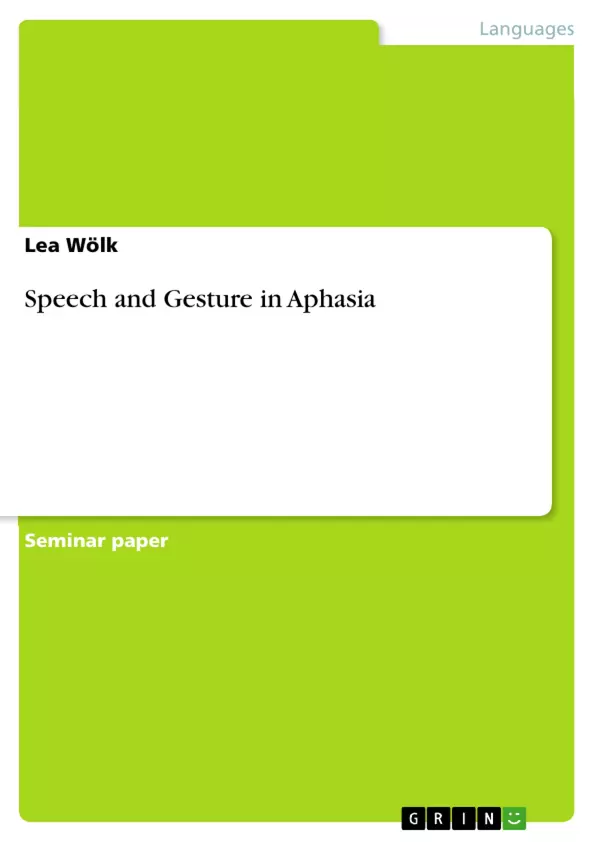The present paper examines this question whether gesture and speech can be treated as going hand-in-hand and, following that, break down together in case of speech impairment following aphasia or if gestures can even have a compensating function when language is no longer usable for an aphasic person. In the first case, one may assume that gesture and speech are “different sides of a single underlying mental process” (cf. McNeill 1992:1); in the second case, gesture and speech are rather independent.
To accomplish this goal, the second chapter takes a closer look at the relationship between gesture and speech and the functions that have been supposed in the case of gesture.
Thirdly, gesture production under pathologic circumstances is assessed by focusing at the topic of gesture production and aphasia. The possibility of a parallel or comparable impair-ment of speech and gesture in aphasia is reviewed, as well as gesture as compensating for speech in persons affected by aphasia (Chapter 3).
The fourth chapter introduces a case study by Lisette Mol, Emiel Krahmer & Mieke van de Sandt-Koenderman (cf. 2012) to further investigate the research question.
The subsequent paragraphs, then, discuss the study by Mol et al. (cf. 2012) in the light of other findings (i.a. Cocks, Middleton & Morgan 2011, McNeill & Duncan 2010; Kita & Özyürek 2003; Glosser, Wiener & Kaplan 1986; Orgassa 2005) regarding the topic (Chapter 4.)
The last chapter draws a conclusion on the question whether speech and language break down in a similar manner and can be regarded as closely related or if gesture can function to compensate for speech in the case of aphasia.
Inhaltsverzeichnis (Table of Contents)
- Introduction
- Gesture and speech production
- Gesture and speech production in aphasia
- Gestures to compensate for speech
- Similar impairment of gesture and speech
- Case Study
- Discussion
- Conclusion
- Bibliography
Zielsetzung und Themenschwerpunkte (Objectives and Key Themes)
This paper investigates the relationship between gesture and speech, particularly in the context of aphasia, a language disorder caused by brain damage. It aims to determine whether gesture and speech are intricately linked and break down together in aphasia, or whether gesture can function as a compensatory mechanism for speech impairments.
- The interplay between verbal and nonverbal communication
- The role of gesture in discourse and spontaneous speaking
- The impact of aphasia on gesture production
- The potential of gesture as a compensatory mechanism for speech impairments in aphasia
- The relationship between gesture and speech production in the context of aphasia
Zusammenfassung der Kapitel (Chapter Summaries)
- The introduction presents the importance of nonverbal communication, highlighting the role of gestures in conveying emotions, social interactions, and discourse. It introduces the concept of aphasia and raises the question of how gesture production is affected by this language disorder.
- Chapter 2 delves into the relationship between gesture and speech production. It discusses various theories proposing a close link between the two, suggesting they express the same idea and are temporally and structurally synchronized. McNeill's theory of gesture and speech as co-existing and intertwined is elaborated on.
- Chapter 3 focuses on gesture production in aphasia. It examines whether speech and gesture impairments occur in parallel or whether gesture can compensate for speech limitations in individuals with aphasia.
- Chapter 4 presents a case study by Lisette Mol, Emiel Krahmer, and Mieke van de Sandt-Koenderman, providing insights into the research question. It investigates the potential for gesture to compensate for speech in aphasia.
- The discussion chapter analyzes the findings of the case study in light of other research on gesture and speech in aphasia. It explores the evidence supporting the idea of gesture as a compensatory mechanism for speech impairments.
Schlüsselwörter (Keywords)
Key terms and concepts explored in this paper include aphasia, gesture, speech production, nonverbal communication, compensatory mechanisms, language impairment, brain damage, and discourse. These terms are central to understanding the complex relationship between gesture and speech, particularly in the context of language disorders such as aphasia.
- Quote paper
- Lea Wölk (Author), 2016, Speech and Gesture in Aphasia, Munich, GRIN Verlag, https://www.grin.com/document/453234



